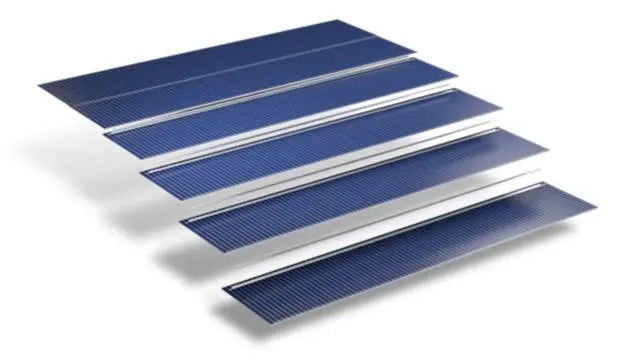Xmas Sale now on - while stocks last
Solaria Power Xt Shingle Solar Panel 170W 12volt 1270X660X30mm - Shingle Array
$298.00
1
/
of
6
No reviews
Out of stock
Regular price
$298.00
Sale price
$298.00
Regular price
$0.00
Unit price
/
per
Tax included.
Shipping calculated at checkout.
GSPD-170
Couldn't load pickup availability
Share this product.
Trusted choice!
Trading since 1975. Over 200k online transactions. All payments methods accepted. Use PayPal for the safest transaction.
Payment methods
Solar Panel 170W VOC 27.95V 1270x660x30mm
The parameters are the value under the standard test conditions (STC) AM=1.5; 1000W/㎡; 25ºC
This allows the cells to be connected differently to conventional solar panels, in that,
there are no busbars (ribbons) required and the solar cells can be joined together
resulting in no gaps between the solar cells.
Shingled solar modules can also be wired differently to conventional solar panels. Typically, solar cells in conventional solar panels are wired in a series of strings whereas the solar cells in shingled panels can be wired in parallel configuration.
What are the advantages of shingled solar panels?
Essentially the three key advantages of the shingled solar panel design are they
produce more power, improve reliability and are aesthetically pleasing.
1. Increased energy harvest Higher power per square metre
The shingled solar cells do not require busbars across the top of the cells so more of
the solar cells are exposed to sunlight. The cells do not need to be spaced apart like
in conventional solar panels so the solar panel area can produce more energy
Outdoor shade testing over a 70-day period has shown that the Solaria Power XT
shingle solar panel performs between 37 to 45% better than conventional solar panel
designs.
2. Better reliability Low busbar failures
Shingle solar panels do away with approximately 30 metres of busbar and soldered
joints that is required on conventional solar panels, so busbar failures are reduced.
Better mechanical performance
Static and dynamic load tests show that the shingle approach is more resistant to
failure due to external forces being applied to the solar panel compared to
conventional solar panels.
3. More attractive Shingled solar panels have no visible circuitry which give them clean simple look providing superior street appeal.
As solar panel technology continues to mature, shingled modules represent the
current state-of-the-art in terms performance, reliability and aesthetics.
The parameters are the value under the standard test conditions (STC) AM=1.5; 1000W/㎡; 25ºC
- Rated Voltage23.65V
- Open circuit voltage 27.95V
- Rated Current 7.19A
- Short circuit current 7.7A
- Outline Dimension 1270*660*30mm
- Weight: 10.3kgs
- Cell Type Mono
- Cell Efficiency ≥21.8%
- Total Efficiency of the Cells Used 177W
- Module Lamination Efficiency 97%
- Maximum System Voltage 500V
- Output Tolerance 0~+3%
- Connector Type MC4
- Module Structure Black aluminum frame/Glass/EVA/Back sheet
- Junction box rating ≥IP67
- Number of Diodes 1
- Working Temperature -40°C~+80°C
This allows the cells to be connected differently to conventional solar panels, in that,
there are no busbars (ribbons) required and the solar cells can be joined together
resulting in no gaps between the solar cells.
Shingled solar modules can also be wired differently to conventional solar panels. Typically, solar cells in conventional solar panels are wired in a series of strings whereas the solar cells in shingled panels can be wired in parallel configuration.
What are the advantages of shingled solar panels?
Essentially the three key advantages of the shingled solar panel design are they
produce more power, improve reliability and are aesthetically pleasing.
1. Increased energy harvest Higher power per square metre
The shingled solar cells do not require busbars across the top of the cells so more of
the solar cells are exposed to sunlight. The cells do not need to be spaced apart like
in conventional solar panels so the solar panel area can produce more energy
Outdoor shade testing over a 70-day period has shown that the Solaria Power XT
shingle solar panel performs between 37 to 45% better than conventional solar panel
designs.
2. Better reliability Low busbar failures
Shingle solar panels do away with approximately 30 metres of busbar and soldered
joints that is required on conventional solar panels, so busbar failures are reduced.
Better mechanical performance
Static and dynamic load tests show that the shingle approach is more resistant to
failure due to external forces being applied to the solar panel compared to
conventional solar panels.
3. More attractive Shingled solar panels have no visible circuitry which give them clean simple look providing superior street appeal.
As solar panel technology continues to mature, shingled modules represent the
current state-of-the-art in terms performance, reliability and aesthetics.






Shopping Safely
At our Shopify store, we prioritize your safety and security. Here's how we ensure a secure shopping experience:
1. Secure Transactions: We use advanced encryption to protect your personal and payment information, ensuring it is safely transmitted and safeguarded.
2. Trusted Payment Gateways: Our store integrates with trusted payment gateways, ensuring your transactions are processed securely and efficiently.
3. Data Privacy: Your privacy is our top priority. We follow strict data protection policies to keep your personal information confidential and secure.
4. Secure Platform: Shopify provides robust security features and continuous monitoring against vulnerabilities, ensuring a safe shopping environment.
5. Verified Merchants: We are a verified merchant on Shopify, committed to providing authentic and high-quality products.
6. Transparent Policies: Our clear return, refund, and shipping policies provide peace of mind, knowing we stand behind our products.
7. Customer Support: Our dedicated customer support team is ready to assist with any concerns or questions you may have.
Shop confidently at our Shopify store, where your safety and satisfaction are our top priorities.
Questions about this product?
Don't be a stranger.
-
Established
1975 Trust in our History
-
With
99% Positive Reviews
-
Over
200k Transactions
Let customers speak for us
from 8172 reviewsRedarc Bcdcmb-001 Mounting Bracket Bcdc ...
Greg Lee
12/23/2025

Redarc Bcdcmb-001 Mounting Bracket Bcdc ...
Piezo Ignitor for 3 Way Fridge RM2350 Electrolux or Dometic Caravan Fridge
Frederick Milham
12/22/2025

Piezo Ignitor for 3 Way Fridge RM2350 Electrolux or Dometic Caravan Fridge
Nemisis wheel clamp
Great seller. Excellent communication and quick delivery. Product as described
Timothy Harte
12/21/2025

Nemesis Wheel Clamp Suits on and Off Road Tyres Up to 275mm 17 inch Rims
Camec 3P Door Lock Hook Catch Caravan Door 143900
Jason Doughty
12/21/2025

Camec 3P Door Lock Hook Catch Caravan Door 143900
Scrunnel funnel.
Happy with funnel, no more spills.
Alison Dick
12/20/2025

Yellow Diesel Scrunnel Funnel
Door Handle Latch for 3 Way RM2453 RM2553 Black Dometic Caravan Fridge
Angus Gamble
12/20/2025

Door Handle Latch for 3 Way RM2453 RM2553 Black Dometic Caravan Fridge
Thetford Aqua Soft Toilet Tissue - 6 Pack
DAVID MORRIS
12/19/2025

Thetford Aqua Soft Toilet Tissue - 6 Pack
Awning Saver
Our caravan awning was starting to show the signs of being out in the weather for 10 years. With the Awning Saver installed it is hoped that we might postpone the inevitable replacement for a little longer. The Awning Saver was easily installed and gives some peace of mind that the awning is less likely to separate from the caravan at the point of attachment.
Graham Stewart
12/18/2025

Awning Saver Awning Repair Pair White
Dometic Lock Light No Lens 2 Pin Left Hand Side Suits RMD-RMDX Fridges
Mark Edwards
12/18/2025

Dometic Lock Light No Lens 2 Pin Left Hand Side Suits RMD-RMDX Fridges
Door lock
Very happy with the service from the company and the product
barry relf
12/17/2025

Control Cover Panel for 3 Way RM2350 Dometic Caravan Fridge
Dometic NRX115C 113 Litre Compressor Fridge and Freezer
Greg Corner
12/17/2025

Dometic NRX115C 113 Litre Compressor Fridge and Freezer
Waeco Dometic PCB Main for All CFverb
charl de beer
12/17/2025

Waeco Dometic PCB Main for All CFverb
External door lock
Prompt delivery, good lock, kept advised of status
Kerrie Zacek
12/17/2025

Thetford Toilet Lock for Zadi Doors Replacement Barrel Only 9007
Goods were as advertised and arrived quickly in good condition fitted as it should. Everybody's happy.
Colin Giddy
12/16/2025

Freezer Door for 3 Way RM2553 RM2453 Electrolux or Dometic Caravan Fridge
Alko 8-inch (200mm) Jockey Wheel Genuine Alko Replacement Wheel
Eddy Vigants
12/16/2025

Alko 8-inch (200mm) Jockey Wheel Genuine Alko Replacement Wheel






